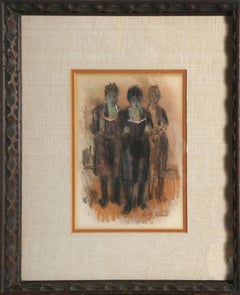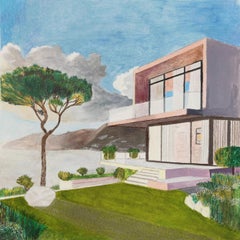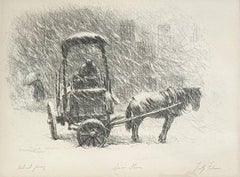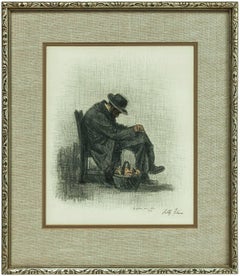Tully Filmus Drawings and Watercolor Paintings
to
1
Overall Width
to
Overall Height
to
1
1
1
1
1
1
1
1
3
844
408
305
282
1
1
Artist: Tully Filmus
Three Figures Reading the Torah, Framed Judaica Drawing by Tully Filmus
By Tully Filmus
Located in Long Island City, NY
Tully Filmus (1903 - 1998) was a Russian/American artist who was known for his realist drawings of Jewish life. This pastel drawing on paper is signed low...
Category
Mid-20th Century American Realist Tully Filmus Drawings and Watercolor Paintings
Materials
Pastel
Related Items
"Dragon, " Original Pastel Drawing
By Quang Ho
Located in Denver, CO
"Dragon," by Quang Ho, is a secondary market work with one previous owner. It is signed and dated (1988) on the lower left. The painting comes with it's original frame (measures 50 x...
Category
20th Century American Realist Tully Filmus Drawings and Watercolor Paintings
Materials
Paper, Pastel
Window onto the Sea, Original Drawing, Contemporary Landscape, Architecture
Located in AIX-EN-PROVENCE, FR
Work : Original Drawing, Handmade Artwork, Unique Work. The work has been treated with UV-resistant varnish and it is not framed.
Medium : Watercolour, Soft Pastel and Oil based col...
Category
21st Century and Contemporary Contemporary Tully Filmus Drawings and Watercolor Paintings
Materials
Color Pencil, Watercolor, Pastel, Archival Paper
H 11.82 in W 11.82 in D 0.12 in
Contemporary Drawing "Blue Prayer" Draw, Pastel, Ink And Colored Pencils
Located in Bogotá, Bogotá
Drawing, pastel, Pencil, Petal Flowers, Color and Ink on Paper.
The base of this drawing is ordinary yellow paper of 80 gr. I use natural dyes from flowers, herbs, leaves, and tree ...
Category
2010s Contemporary Tully Filmus Drawings and Watercolor Paintings
Materials
Paper, Pastel, Ink, Pencil, Color Pencil
Winter landscape - XX century, Pastel figurative, Blue tones, Realism
Located in Warsaw, PL
Pastel on paper, 2000.
EDMUND MUC - Master of Fine Arts, specialized in sculpting. Lecturer at Fine Arts Departament of Jan Długosz Academy in Częstochowa ...
Category
2010s Other Art Style Tully Filmus Drawings and Watercolor Paintings
Materials
Pastel, Cardboard
Fruit by Alphonse Mucha
By Alphonse Mucha
Located in New Orleans, LA
Alphonse Mucha
1860-1939 Czech
Fruit
Signed "Mucha" (lower left)
Pastel on paper
"Art only exists to communicate a spiritual message." —Alphonse Mucha
Alphonse Mucha's distincti...
Category
19th Century Art Nouveau Tully Filmus Drawings and Watercolor Paintings
Materials
Paper, Pastel
Standing Female Figurative Nude in Watercolor and Pastel on Paper by B. Warde
Located in Soquel, CA
Standing Female Figurative Nude in Watercolor and Pastel on Paper
A woman is depicted standing, presumably pregnant, in the nude with her hand on the small of her back. The artist u...
Category
1970s Abstract Expressionist Tully Filmus Drawings and Watercolor Paintings
Materials
Paper, Pastel, Watercolor
H 30 in W 36 in D 0.25 in
Portrait of Nude Female Figure on Paper, Woman With Knees Up by America Martin
By America Martin
Located in 326 N Coast Hwy. | Laguna Beach, CA
America Martin
"Woman With Knees Up"
Pastel & Ink on Paper
24” x 18”
AMERICA MARTIN is an internationally represented Colombian-American fine artist based in Los Angeles. America i...
Category
Early 2000s Contemporary Tully Filmus Drawings and Watercolor Paintings
Materials
Pastel, Ink
Eileen Lake
By Adolf Arthur Dehn
Located in Fairlawn, OH
Eileen Lake
Crayon on paper, early1930's
Initialed in pencil lower right (see photo)
Titled and annotated verso "Eileen Lake, early 1930s girlfriend"
Note: Eileen Hall Lake was an American poet and Adolf Dehn's girlfriend in the early 1930s.
Provenance:
Estate of the artist
By descent
Adolf Dehn, American Watercolorist and Printmaker, 1895-1968
Adolf Dehn was an artist who achieved extraordinary artistic heights, but in a very particular artistic sphere—not so much in oil painting as in watercolor and lithography. Long recognized as a master by serious print collectors, he is gradually gaining recognition as a notable and influential figure in the overall history of American art.
In the 19th century, with the invention of the rotary press, which made possible enormous print runs, and the development of the popular, mass-market magazines, newspaper and magazine illustration developed into an artistic realm of its own, often surprisingly divorced from the world of museums and art exhibitions, and today remains surprisingly overlooked by most art historians. Dehn in many regards was an outgrowth of this world, although in an unusual way, since as a young man he produced most of his illustrative work not for popular magazines, such as The Saturday Evening Post, but rather for radical journals, such as The Masses or The Liberator, or artistic “little magazines” such as The Dial. This background established the foundation of his outlook, and led later to his unique and distinctive contribution to American graphic art.
If there’s a distinctive quality to his work, it was his skill in introducing unusual tonal and textural effects into his work, particularly in printmaking but also in watercolor. Jackson Pollock seems to have been one of many notable artists who were influenced by his techniques.
Early Years, 1895-1922
For an artist largely remembered for scenes of Vienna and Paris, Adolf Dehn’s background was a surprising one. Born in Waterville, Minnesota, on November 22, 1895, Dehn was the descendent of farmers who had emigrated from Germany and homesteaded in the region, initially in a one-room log cabin with a dirt floor. Adolf’s father, Arthur Clark Dehn, was a hunter and trapper who took pride that he had no boss but himself, and who had little use for art. Indeed, during Adolf’s boyhood the walls of his bedroom and the space under his bed were filled with the pelts of mink, muskrats and skunks that his father had killed, skinned and stretched on drying boards. It was Adolf’s mother, Emilie Haas Dehn, a faithful member of the German Lutheran Evangelical Church, who encouraged his interest in art, which became apparent early in childhood. Both parents were ardent socialists, and supporters of Eugene Debs. In many ways Dehn’s later artistic achievement was clearly a reaction against the grinding rural poverty of his childhood.
After graduating from high school in 1914 at the age of 19—an age not unusual in farming communities at the time, where school attendance was often irregular—Dehn attended the Minneapolis School of Art from 1914 to 1917, whose character followed strongly reflected that of its director, Munich-trained Robert Kohler, an artistic conservative but a social radical. There Dehn joined a group of students who went on to nationally significant careers, including Wanda Gag (later author of best-selling children’s books); John Flanagan (a sculptor notable for his use of direct carving) Harry Gottlieb (a notable social realist and member of the Woodstock Art Colony), Elizabeth Olds (a printmaker and administrator for the WPA), Arnold Blanch (landscape, still-life and figure painter, and member of the Woodstock group), Lucille Lunquist, later Lucille Blanch (also a gifted painter and founder of the Woodstock art colony), and Johan Egilrud (who stayed in Minneapolis and became a journalist and poet).
Adolf became particularly close to Wanda Gag (1893-1946), with whom he established an intense but platonic relationship. Two years older than he, Gag was the daughter of a Bohemian artist and decorator, Anton Gag, who had died in 1908. After her husband died, Wanda’s mother, Lizzi Gag, became a helpless invalid, so Wanda was entrusted with the task of raising and financially supporting her six younger siblings. This endowed her with toughness and an independent streak, but nonetheless, when she met Dehn, Wanda was Victorian and conventional in her artistic taste and social values. Dehn was more socially radical, and introduced her to radical ideas about politics and free love, as well as to socialist publications such as The Masses and The Appeal to Reason.
Never very interested in oil painting, in Minneapolis Dehn focused on caricature and illustration--often of a humorous or politically radical character. In 1917 both Dehn and Wanda won scholarships to attend the Art Students League, and consequently, in the fall of that year both moved to New York. Dehn’s art education, however, ended in the summer of 1918, shortly after the United States entered World War I, when he was drafted to serve in the U. S. Army. Unwilling to fight, he applied for status as a conscientious objector, but was first imprisoned, then segregated in semi-imprisonment with other Pacifists, until the war ended. The abuse he suffered at this time may well explain his later withdrawal from taking political stands or making art of an overtly political nature. After his release from the army, Dehn returned to New York where he fell under the spell of the radical cartoonist Boardman Robinson and produced his first lithographs. He also finally consummated his sexual relationship with Wanda Gag.
The Years in Europe: 1922-1929
In September of 1921, however, he abruptly departed for Europe, arriving in Paris and then moving on to Vienna. There in the winter of 1922 he fell in love with a Russian dancer, Mura Zipperovitch, ending his seven-year relationship with Wanda Gag. He and Mura were married in 1926. It was also in Vienna that he produced his first notable artistic work.
Influenced by European artists such as Jules Pascin and Georg Grosz, Dehn began producing drawings of people in cafes, streets, and parks, which while mostly executed in his studio, were based on spontaneous life studies and have an expressive, sometimes almost childishly wandering quality of line. The mixture of sophistication and naiveté in these drawings was new to American audiences, as was the raciness of their subject matter, which often featured pleasure-seekers, prostitutes or scenes of sexual dalliance, presented with a strong element of caricature. Some of these drawings contain an element of social criticism, reminiscent of that found in the work of George Grosz, although Dehn’s work tended to focus on humorous commentary rather than savagely attacking his subjects or making a partisan political statement. Many Americans, including some who had originally been supporters of Dehn such as Boardman Robinson, were shocked by these European drawings, although George Grocz (who became a friend of the artist in this period) admired them, and recognized that Dehn could also bring a new vision to America subject matter. As he told Dehn: “You will do things in America which haven’t been done, which need to be done, which only you can do—as far at least as I know America.”
A key factor in Dehn’s artistic evolution at this time was his association with Scofield Thayer...
Category
1930s American Realist Tully Filmus Drawings and Watercolor Paintings
Materials
Oil Crayon
Modern Colorful Pastel Drawing of a Pair of Sumo Wrestlers in Blue and Green
Located in Houston, TX
Modern pastel drawing of a pair of sumo wrestlers in the middle of a match wearing green and blue mawashi set against an orange floor. Signed by the artist in the front lower right c...
Category
20th Century Modern Tully Filmus Drawings and Watercolor Paintings
Materials
Pastel
H 32.75 in W 40.38 in D 1.13 in
Pirate Ship - Skull-and-Crossbones Seven Seas Illustration in White and Blue
By Jamie Wyeth
Located in Miami, FL
The Skull-and-Crossbones flag flies atop this illustration of a Pirate Ship. Two palm trees flank it, and it floats in a cropped stylized sea. A single hatted figure is seen looking ...
Category
1970s American Realist Tully Filmus Drawings and Watercolor Paintings
Materials
Pastel, Ink, Board
Modern Colorful Pastel Drawing of a Pair of Competing Sumo Wrestlers in Red
Located in Houston, TX
Modern pastel drawing of a pair of sumo wrestlers in the middle of a match wearing red mawashi set against a grey floor. Signed by the artist in the front lower right corner. Current...
Category
20th Century Modern Tully Filmus Drawings and Watercolor Paintings
Materials
Pastel
H 31.88 in W 39.25 in D 1.25 in
Modern Pastel Figurative Drawing of a Seated Resting Sumo Wrestler with Kimono
Located in Houston, TX
Modern pastel drawing of a sumo wrestler resting after a match with a kimono or blanket draped over his shoulders. Signed by the artist in the front lower right corner. Currently hun...
Category
20th Century Modern Tully Filmus Drawings and Watercolor Paintings
Materials
Pastel
H 39.5 in W 31.75 in D 1.25 in
Previously Available Items
Judaica Lithograph "Winter" Jewish Hasidic Shtetl Life NY Lower East Side
By Tully Filmus
Located in Surfside, FL
Framed 23 x 30.5 image 16 x 21.
Tully Filmus was an American realist painter. Well known for his Judaica Paintings done with warmth and sensitivity, Jewish subject matter was not b...
Category
20th Century Post-Impressionist Tully Filmus Drawings and Watercolor Paintings
Materials
Paper, Lithograph
the Bagel Seller, Jewish Man Sleeping, Judaica Pastel Drawing
By Tully Filmus
Located in Surfside, FL
Genre: Judaica
Subject: People
Medium: Pastel
Surface: Paper
Country: United States
Dimensions w/Frame: 24 1/4" x 20 3/4"
Tully Filmus was an American realist painter. He was born N...
Category
1970s Folk Art Tully Filmus Drawings and Watercolor Paintings
Materials
Oil Pastel, Pencil
H 24.25 in W 20.75 in
Tully Filmus drawings and watercolor paintings for sale on 1stDibs.
Find a wide variety of authentic Tully Filmus drawings and watercolor paintings available for sale on 1stDibs. You can also browse by medium to find art by Tully Filmus in crayon, pastel and more. Not every interior allows for large Tully Filmus drawings and watercolor paintings, so small editions measuring 17 inches across are available. Customers who are interested in this artist might also find the work of Raphael Soyer, Peter Driben, and Jared French. Tully Filmus drawings and watercolor paintings prices can differ depending upon medium, time period and other attributes. On 1stDibs, the price for these items starts at $1,800 and tops out at $1,800, while the average work can sell for $1,800.




